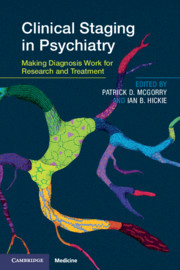Book contents
- Clinical Staging in Psychiatry
- Clinical Staging in Psychiatry
- Copyright page
- Contents
- Contributors
- Foreword
- Acknowledgements
- Section 1 Conceptual and Strategic Issues
- Section 2 Progress with Clinical Staging
- Chapter 5 The Utility of Clinical Staging in Youth Mental Health Settings
- Chapter 6 Neuroimaging and Staging
- Chapter 7 Staging of Cognition in Psychiatric Illness
- Chapter 8 Neuroinflammation and Staging
- Chapter 9 Bioactive and Inflammatory Markers in Emerging Psychotic Disorders
- Chapter 10 Electroencephalography and Staging
- Section 3 Novel Treatment Strategies
- Section 4 Novel Treatment Strategies
- Index
- Plate Section (PDF Only)
- References
Chapter 7 - Staging of Cognition in Psychiatric Illness
from Section 2 - Progress with Clinical Staging
Published online by Cambridge University Press: 08 August 2019
- Clinical Staging in Psychiatry
- Clinical Staging in Psychiatry
- Copyright page
- Contents
- Contributors
- Foreword
- Acknowledgements
- Section 1 Conceptual and Strategic Issues
- Section 2 Progress with Clinical Staging
- Chapter 5 The Utility of Clinical Staging in Youth Mental Health Settings
- Chapter 6 Neuroimaging and Staging
- Chapter 7 Staging of Cognition in Psychiatric Illness
- Chapter 8 Neuroinflammation and Staging
- Chapter 9 Bioactive and Inflammatory Markers in Emerging Psychotic Disorders
- Chapter 10 Electroencephalography and Staging
- Section 3 Novel Treatment Strategies
- Section 4 Novel Treatment Strategies
- Index
- Plate Section (PDF Only)
- References
Summary
While cognitive disturbances are core to psychiatric illnesses, the timing and progression of impairments and whether they fit with a staging model remains an open question. Cognitive deficits can emerge as early neurodevelopmental or trait-based markers of illness, state-based disturbances that co-occur with psychiatric symptoms, and/or may progress over time. In this chapter, a review of the literature on cognitive functioning in major psychiatric disorders within the clinical staging model is presented. Most of the existing research has examined cognition in separate diagnostic groups, but mixed or transdiagnostic studies are included where possible in an attempt to draw on commonalities across psychopathology. Cognition research has dominated the psychosis field for decades, with strong evidence that impairments emerge early and tend to remain relatively stable in individuals. The evidence for progression of cognitive impairment in psychiatric disorder is limited, but the strongest evidence for progression is in mood disorders, where there has been a recent growth of research. Anxiety and eating disorders have also received increasing attention, with evidence of cognitive impairment in cross-sectional studies, but longitudinal research is needed. Given the significant heterogeneity in cognitive functioning between and within psychiatric disorder groups, a staging model of cognition that can be applied transdiagnostically may be the way forward, so that the cognitive profile of the individual informs functional prognosis and the appropriate and individualised delivery of treatments.
- Type
- Chapter
- Information
- Clinical Staging in PsychiatryMaking Diagnosis Work for Research and Treatment, pp. 140 - 171Publisher: Cambridge University PressPrint publication year: 2019
References
- 3
- Cited by



